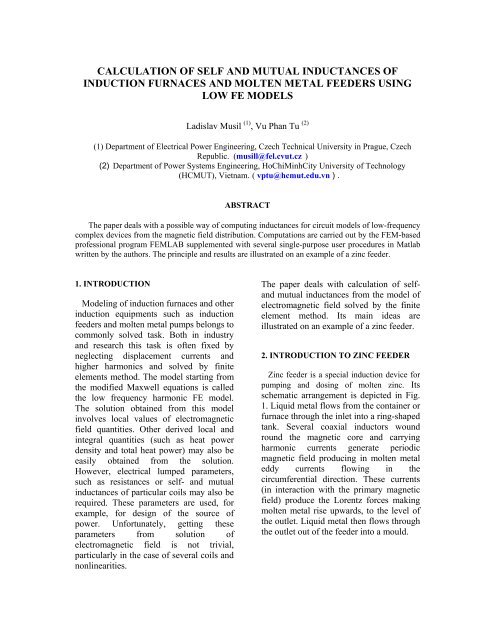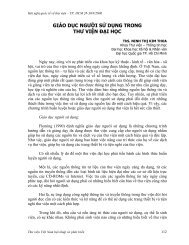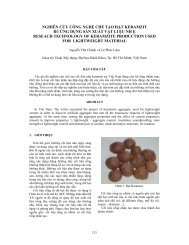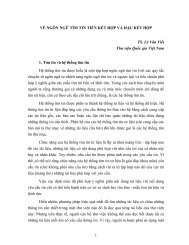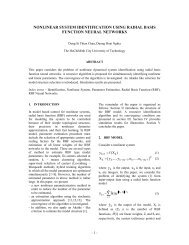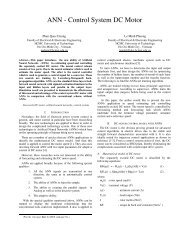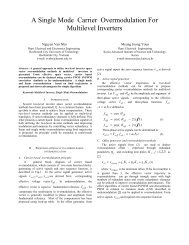calculation of self and mutual inductances of induction furnaces and ...
calculation of self and mutual inductances of induction furnaces and ...
calculation of self and mutual inductances of induction furnaces and ...
Create successful ePaper yourself
Turn your PDF publications into a flip-book with our unique Google optimized e-Paper software.
CALCULATION OF SELF AND MUTUAL INDUCTANCES OF<br />
INDUCTION FURNACES AND MOLTEN METAL FEEDERS USING<br />
LOW FE MODELS<br />
Ladislav Musil (1) , Vu Phan Tu (2)<br />
(1) Department <strong>of</strong> Electrical Power Engineering, Czech Technical University in Prague, Czech<br />
Republic. (musill@fel.cvut.cz )<br />
(2) Department <strong>of</strong> Power Systems Engineering, HoChiMinhCity University <strong>of</strong> Technology<br />
(HCMUT), Vietnam. ( vptu@hcmut.edu.vn ) .<br />
ABSTRACT<br />
The paper deals with a possible way <strong>of</strong> computing <strong>inductances</strong> for circuit models <strong>of</strong> low-frequency<br />
complex devices from the magnetic field distribution. Computations are carried out by the FEM-based<br />
pr<strong>of</strong>essional program FEMLAB supplemented with several single-purpose user procedures in Matlab<br />
written by the authors. The principle <strong>and</strong> results are illustrated on an example <strong>of</strong> a zinc feeder.<br />
1. INTRODUCTION<br />
Modeling <strong>of</strong> <strong>induction</strong> <strong>furnaces</strong> <strong>and</strong> other<br />
<strong>induction</strong> equipments such as <strong>induction</strong><br />
feeders <strong>and</strong> molten metal pumps belongs to<br />
commonly solved task. Both in industry<br />
<strong>and</strong> research this task is <strong>of</strong>ten fixed by<br />
neglecting displacement currents <strong>and</strong><br />
higher harmonics <strong>and</strong> solved by finite<br />
elements method. The model starting from<br />
the modified Maxwell equations is called<br />
the low frequency harmonic FE model.<br />
The solution obtained from this model<br />
involves local values <strong>of</strong> electromagnetic<br />
field quantities. Other derived local <strong>and</strong><br />
integral quantities (such as heat power<br />
density <strong>and</strong> total heat power) may also be<br />
easily obtained from the solution.<br />
However, electrical lumped parameters,<br />
such as resistances or <strong>self</strong>- <strong>and</strong> <strong>mutual</strong><br />
<strong>inductances</strong> <strong>of</strong> particular coils may also be<br />
required. These parameters are used, for<br />
example, for design <strong>of</strong> the source <strong>of</strong><br />
power. Unfortunately, getting these<br />
parameters from solution <strong>of</strong><br />
electromagnetic field is not trivial,<br />
particularly in the case <strong>of</strong> several coils <strong>and</strong><br />
nonlinearities.<br />
The paper deals with <strong>calculation</strong> <strong>of</strong> <strong>self</strong><strong>and</strong><br />
<strong>mutual</strong> <strong>inductances</strong> from the model <strong>of</strong><br />
electromagnetic field solved by the finite<br />
element method. Its main ideas are<br />
illustrated on an example <strong>of</strong> a zinc feeder.<br />
2. INTRODUCTION TO ZINC FEEDER<br />
Zinc feeder is a special <strong>induction</strong> device for<br />
pumping <strong>and</strong> dosing <strong>of</strong> molten zinc. Its<br />
schematic arrangement is depicted in Fig.<br />
1. Liquid metal flows from the container or<br />
furnace through the inlet into a ring-shaped<br />
tank. Several coaxial inductors wound<br />
round the magnetic core <strong>and</strong> carrying<br />
harmonic currents generate periodic<br />
magnetic field producing in molten metal<br />
eddy currents flowing in the<br />
circumferential direction. These currents<br />
(in interaction with the primary magnetic<br />
field) produce the Lorentz forces making<br />
molten metal rise upwards, to the level <strong>of</strong><br />
the outlet. Liquid metal then flows through<br />
the outlet out <strong>of</strong> the feeder into a mould.
3. MATHEMATICAL MODEL<br />
a. Electromagnetic field model<br />
Induction devices are usually supplied by<br />
currents <strong>of</strong> frequency low enough, that the<br />
displacement currents can be omitted.<br />
Electromagnetic field can be than<br />
described by equation<br />
1<br />
curl<br />
⎛ ⎜ curl<br />
⎞ ⎟ γ<br />
∂<br />
ext<br />
μ<br />
+ ⋅ A<br />
A<br />
⎝ ⎠ ∂t<br />
= J (1)<br />
where A defined the vector potential<br />
defined as: curl A=<br />
B.<br />
As far as the magnetic core is not<br />
expected to be fully saturated, all material<br />
parameters may be considered<br />
approximately constant. The model <strong>of</strong> the<br />
feeder is then linear. This simplifying<br />
assumption allows the computations <strong>of</strong><br />
electromagnetic field to be carried out in a<br />
complex plane using the harmonic<br />
analysis.<br />
Distribution <strong>of</strong> the electromagnetic field<br />
is now described by equation<br />
Fig. 1: Basic arrangement <strong>of</strong> the feeder<br />
The feeder works in two main regimes:<br />
regime <strong>of</strong> dozing <strong>and</strong> regime <strong>of</strong> heating.<br />
During the regime <strong>of</strong> dozing magnetic field<br />
in the system is produced by inductors 2<br />
<strong>and</strong> 3 (the Lorentz forces acting mainly in<br />
the bottom layers <strong>of</strong> melt are high). During<br />
the regime <strong>of</strong> heating the molten metal is<br />
kept at an approximately constant<br />
temperature (its cooling <strong>and</strong> eventual<br />
solidification might damage the refractory)<br />
by means <strong>of</strong> <strong>induction</strong> heating. Magnetic<br />
field in this regime is produced by<br />
inductors 1 <strong>and</strong> 2. Electromagnetic forces<br />
are now low <strong>and</strong> do not push the metal out<br />
<strong>of</strong> the feeder. In order to find the time <strong>of</strong><br />
filling the mould it is necessary to know<br />
dynamics <strong>of</strong> the device (at least at the stage<br />
<strong>of</strong> design) as accurately as possible.<br />
( ) + = ext<br />
curl curl A jμωγ A μJ (2)<br />
The harmonic analysis enormously<br />
reduces the computation time, effort <strong>and</strong><br />
stability. However, when a magnetic core<br />
is present, it is <strong>of</strong>ten not fully possible to<br />
neglect its saturation. In such a case we use<br />
a special model <strong>of</strong> nonlinear harmonic<br />
analysis. This model also considers a<br />
constant permeability, but its local value<br />
depends on the local magnetic flux density<br />
amplitude. The electromagnetic field is<br />
then described by equation.<br />
⎛ 1 ⎞<br />
curl curl + jωγ =<br />
⎜μ<br />
( ) ⎟<br />
⎝<br />
B<br />
A A J<br />
⎠<br />
ext<br />
(3)<br />
The above models <strong>of</strong> electromagnetic<br />
field can be solved by the finite element<br />
method. In the next text we will discuss the
ways <strong>of</strong> determination <strong>of</strong> <strong>inductances</strong><br />
starting from them. But because <strong>of</strong> rather<br />
limited space, only computation starting<br />
from the last model will be illustrated on<br />
one example. Nevertheless, this example<br />
involves most <strong>of</strong> the phenomena that can<br />
complicate the <strong>calculation</strong>: several current<br />
carrying inductors, ferromagnetic core <strong>and</strong><br />
a zinc area with surface currents.<br />
b. Computation <strong>of</strong> <strong>inductances</strong><br />
Inductance <strong>of</strong> a solitary coil in linear<br />
surroundings can easily be computed from<br />
the total energy <strong>of</strong> electromagnetic field<br />
<strong>and</strong> its value follows from formula<br />
2W<br />
L = (4)<br />
I 2<br />
In case that the task is nonlinear, the<br />
inductance must satisfy equations<br />
dW<br />
= UI<br />
dt<br />
(5)<br />
d LI<br />
U = .<br />
dt<br />
(6)<br />
valid in circuit models with lumped<br />
parameters. Combining both above formulas,<br />
the differential <strong>of</strong> energy W can be expressed<br />
as<br />
dW = Id<br />
LI<br />
(7)<br />
Consider now a linearized problem obtained<br />
by setting the local permeability to its<br />
instantaneous constant value. Inductance in<br />
such a modified problem is then independent<br />
<strong>of</strong> current. The differential <strong>of</strong> energy is given<br />
by<br />
dW = LId<br />
I<br />
(8)<br />
The second differential <strong>of</strong> the energy is<br />
d2<br />
( d ) 2<br />
W = L I<br />
(9)<br />
The <strong>self</strong>-inductance can be then defined as a<br />
second derivative <strong>of</strong> magnetic field energy <strong>of</strong> a<br />
linearized system due with respect to current<br />
∂2W<br />
L = (10)<br />
∂ I 2<br />
This derivation can easily be extended to<br />
definition <strong>of</strong> <strong>self</strong>- <strong>and</strong> <strong>mutual</strong> <strong>inductances</strong> in<br />
systems with more inductors. That is why this<br />
definition can be useful even in linear<br />
problems. The derivation for the case <strong>of</strong> two<br />
coils as follows<br />
In circuit models with two magnetically<br />
coupled coils the following equations have to<br />
be satisfied<br />
dW = UI 11+ U 2 I 2<br />
dt<br />
(11)<br />
dI1 dI2<br />
U1 L11 M12<br />
dt<br />
dt<br />
(12)<br />
dI2 dI1<br />
U2 L22 M12<br />
dt<br />
dt<br />
(13)<br />
(all coefficients expressing the <strong>self</strong>- <strong>and</strong><br />
<strong>mutual</strong> <strong>inductances</strong> being assumed constants).<br />
From these equations a differential <strong>of</strong> magnetic<br />
field energy can be expressed as<br />
( )<br />
dW = L11 I dI1+ M12 I1dI2+ I2dI1 + L2I2dI2<br />
(14)<br />
Now the second differential reads<br />
d W = L dI + 2M dI dI + L dI<br />
(15)<br />
2 2 2<br />
1 1 12 1 2 2 2<br />
<strong>and</strong> the <strong>inductances</strong> can be expressed as<br />
L<br />
11<br />
∂2W<br />
= , M ∂ I<br />
2<br />
1<br />
12<br />
∂2W<br />
= , L ∂ I ∂ I<br />
1 2<br />
22<br />
∂2W<br />
= (16) ∂ I<br />
2<br />
2<br />
where the derivatives are carried out on a<br />
linearized model with locally time invariable<br />
permeability.<br />
This model <strong>and</strong> definition is applicable in<br />
both linear models <strong>and</strong> models with variable<br />
permeability, but not in models with<br />
hysteresis. When hysteresis occurs, magnetic<br />
field cannot be modeled by only <strong>self</strong>- <strong>and</strong><br />
<strong>mutual</strong> <strong>inductances</strong> in circuit models. A more<br />
complicated model involving some resistances<br />
must then be implemented because <strong>of</strong> losses in<br />
a ferromagnetic material.
4. CIRCUIT MODEL OF ZINC FEEDER<br />
The zinc feeder was modeled in the<br />
regime <strong>of</strong> dosing. Self- <strong>and</strong> <strong>mutual</strong> <strong>inductances</strong><br />
<strong>of</strong> two operating inductors <strong>and</strong> a shortcircuited<br />
winding represented by the ring<br />
shaped zinc volume were computed. The<br />
computation was carried out for various zinc<br />
levels in the feeder.<br />
First we calculated the distribution <strong>of</strong><br />
harmonic electromagnetic field. The<br />
computation was nonlinear because the<br />
permeability depends on the resultant field<br />
distribution. The field distribution provided the<br />
distribution <strong>of</strong> permeability in the magnetic<br />
core <strong>and</strong> current density in zinc. These results<br />
were used for further computations <strong>of</strong><br />
electromagnetic field for several different<br />
values <strong>of</strong> total current in particular coils (<strong>and</strong>,<br />
consequently, in zinc) that were carried out in<br />
order to obtain the total magnetic energy for<br />
different currents. Its second derivatives with<br />
respect to the corresponding currents then<br />
provide the above <strong>self</strong>- <strong>and</strong> <strong>mutual</strong><br />
<strong>inductances</strong>. We used the following formulas:<br />
2<br />
∂ wE<br />
=<br />
2 L<br />
i<br />
∂I<br />
i<br />
wE Ii I wE Ii wE Ii<br />
I<br />
<br />
2<br />
ΔI<br />
( +Δ ) − 2 ( ) + ( −Δ )<br />
(17)<br />
I<br />
i<br />
= 0 for <strong>self</strong>- <strong>and</strong> { Ii, I<br />
j} = { ΔI,<br />
−Δ I}<br />
for<br />
<strong>mutual</strong> <strong>inductances</strong> <strong>and</strong> the current difference<br />
Δ I for <strong>mutual</strong> <strong>inductances</strong> was half <strong>of</strong> the<br />
difference for the <strong>self</strong>-inductance. With the<br />
fact that wE( I) = wE( − I)<br />
, the formulae for<br />
computation <strong>of</strong> <strong>inductances</strong> can then be<br />
simplified to the form<br />
2<br />
w E<br />
2 w<br />
= L E<br />
2 i<br />
=<br />
2<br />
Ii<br />
ΔI<br />
∂<br />
∂<br />
2<br />
∂ wE<br />
∂I ∂I<br />
i<br />
j<br />
( ΔI)<br />
(19)<br />
( Δ ,0) + ( 0, Δ ) − ( Δ , −Δ )<br />
wE I wE I wE<br />
I I<br />
= M<br />
ij<br />
=<br />
2<br />
ΔI<br />
(20)<br />
The electromagnetic field was computed as<br />
two dimensional because its geometry is<br />
almost completely axi-symmetric.<br />
Computation was done in the complex domain<br />
(using the harmonic analysis) by FEM-based<br />
pr<strong>of</strong>essional code FEMLAB supplemented<br />
with several single purpose codes written in<br />
Matlab by the authors.<br />
The magnetic core was considered<br />
nonconductive. Its permeability is expected to<br />
be constant in time, but dependent on the<br />
effective value <strong>of</strong> local magnetic flux density.<br />
The dependence between relative permeability<br />
<strong>and</strong> effective value <strong>of</strong> magnetic field density is<br />
depicted in Fig.2<br />
=<br />
2<br />
∂ wE<br />
∂I ∂I<br />
( +Δ , +Δ ) ⎤<br />
⎥<br />
( , ) ⎥<br />
E i j ⎦<br />
E( i<br />
−Δ<br />
j<br />
+Δ )<br />
wE( Ii I,<br />
I<br />
j<br />
I)<br />
⎡⎡wE Ii I I<br />
j<br />
I ⎤<br />
⎢⎢<br />
⎥<br />
⎢⎢<br />
1<br />
− w I +ΔI I −ΔI<br />
⎥<br />
⎢⎣<br />
⎥<br />
ΔI ⎢ ⎡w I I I I ⎤⎥<br />
⎢− ⎢ ⎥⎥<br />
⎢ ⎢− −Δ −Δ ⎥⎥<br />
⎣ ⎣<br />
⎦⎦<br />
2<br />
4 ,<br />
i<br />
j<br />
= M<br />
ij<br />
(18)<br />
Relative permeability (-)<br />
1000<br />
800<br />
600<br />
400<br />
200<br />
0<br />
0 0.2 0.4 0.6 0.8 1<br />
Magnetic field density (T)<br />
where I is the basic current <strong>and</strong> Δ I is the<br />
current difference. Due to linearity <strong>of</strong> the<br />
model the basic current can be chosen quite<br />
arbitrarily.<br />
To minimize the number <strong>of</strong> magnetic field<br />
energy computations <strong>and</strong> also the numerical<br />
error, the point <strong>of</strong> derivation was chosen<br />
Fig. 2: Dependence <strong>of</strong> the relative permeability on<br />
magnetic flux density used in computations<br />
The feeder was modeled in the operation<br />
regime <strong>of</strong> dosing. Therefore, only the two<br />
lower inductors are considered in the model.<br />
The inductors carry harmonic source currents.<br />
The influence <strong>of</strong> skin-effect in the inductors is<br />
neglected.
A resultant distribution <strong>of</strong> magnetic field is<br />
depicted in Fig. 3, for the medium level <strong>of</strong><br />
zinc.<br />
A circuit model <strong>of</strong> the feeder consists <strong>of</strong><br />
three <strong>mutual</strong>ly magnetically coupled<br />
<strong>inductances</strong> <strong>and</strong> several resistors (Fig. 4). Each<br />
inductance represents either one <strong>of</strong> the<br />
inductors or the zinc volume:<br />
inductance L 2 - inductor No. 2,<br />
inductance L 3 - inductor No. 3,<br />
inductance L z - zinc.<br />
distribution <strong>of</strong> currents <strong>and</strong> permeability<br />
should be, however, the same for all these<br />
partial computations. Therefore, the real<br />
permeability <strong>and</strong> current density in zinc had to<br />
be found out. The permeability is than fixed<br />
<strong>and</strong> wanted current through zinc volume is<br />
obtained by multiplying the real current<br />
density by a suitable constant.<br />
Inductances M 2z , L z <strong>and</strong> M z3 are dependent on<br />
the zinc level. The zinc level in the feeder<br />
varies from 0.16 m to 0.33 m. These<br />
dependencies were also computed <strong>and</strong> are<br />
depicted in Fig. 5.<br />
10.5 x 10-7 Zinc level (m)<br />
10<br />
L z<br />
(H)<br />
9.5<br />
9<br />
8.5<br />
0.2 0.25 0.3 0.35<br />
1.1<br />
Fig. 3: Distribution <strong>of</strong> magnetic field for the medium level <strong>of</strong><br />
zinc<br />
M z2<br />
(H)<br />
1.05<br />
Resistors respect heat losses in the inductors<br />
or zinc.<br />
1<br />
1.15 x 10-5 Zinc level (m)<br />
0.2 0.25 0.3 0.35<br />
M z2<br />
2.4<br />
L 3<br />
L z<br />
R z<br />
M z3<br />
(H)<br />
2.3<br />
2.2<br />
2.1<br />
2.5 x 10-5 Zinc level (m)<br />
R 2<br />
M 23<br />
L 3<br />
M z3<br />
0.2 0.25 0.3 0.35<br />
Fig. 4: A circuit model <strong>of</strong> the zinc feeder<br />
R 3<br />
During computation <strong>of</strong> the <strong>inductances</strong>,<br />
magnetic fields produced by several different<br />
currents have to be determined. The<br />
Fig. 5: Dependencies <strong>of</strong> inductance <strong>of</strong> zinc L z <strong>and</strong> <strong>mutual</strong><br />
<strong>inductances</strong> between zinc <strong>and</strong> inductors No. 2 <strong>and</strong> 3 (M z2 <strong>and</strong><br />
M z3) on the level <strong>of</strong> zinc in the feeder<br />
The resultant values <strong>of</strong> <strong>inductances</strong> for zinc<br />
level 0.24 m were introduced into the circuit<br />
model <strong>of</strong> the feeder (see Fig. 6). Also<br />
resistances were computed. The resistance <strong>of</strong><br />
zinc volume was computed from the heat<br />
power induced in the volume <strong>and</strong> resistances
<strong>of</strong> coil were obtained from geometry <strong>and</strong><br />
material resistivity, where the skin-effect in<br />
inductors was neglected again.<br />
10 μH<br />
152 μH<br />
0.9 μH<br />
45 μΩ<br />
5 mΩ<br />
283 μH<br />
874 μH<br />
22 μH<br />
8.6 mΩ<br />
Fig. 6: The circuit model <strong>of</strong> the feeder computed for the zinc<br />
level <strong>of</strong> 0.24 m<br />
5. CONCLUSION<br />
One computation way <strong>of</strong> <strong>self</strong> <strong>and</strong> <strong>mutual</strong><br />
<strong>inductances</strong> from magnetic field distribution is<br />
presented. The computation is feasible for both<br />
linear <strong>and</strong> nonlinear tasks. The method used<br />
for creation <strong>of</strong> the circuit model <strong>of</strong> a zinc<br />
feeder. This circuit model can be used for<br />
design <strong>of</strong> supply for the device.<br />
REFERENCES<br />
[1] Haňka, L.: Theory <strong>of</strong> electromagnetic field,<br />
TKI, Bratislava, 1975 (in Czech)<br />
[2] Sadiku, M.N.O.: Numerical Techniques in<br />
Electromagnetics, CRC Press LLC, Florida,<br />
2000, ISBN 0-8493-1395-3<br />
[3] Press, W.H., Teukolsky, S.A., Vetterling<br />
W. T., Flannery, B.P.: Numerical Recipes in<br />
C++, Cambridge University Press, Cambridge,<br />
2002, ISBN 0-521-75033-4


